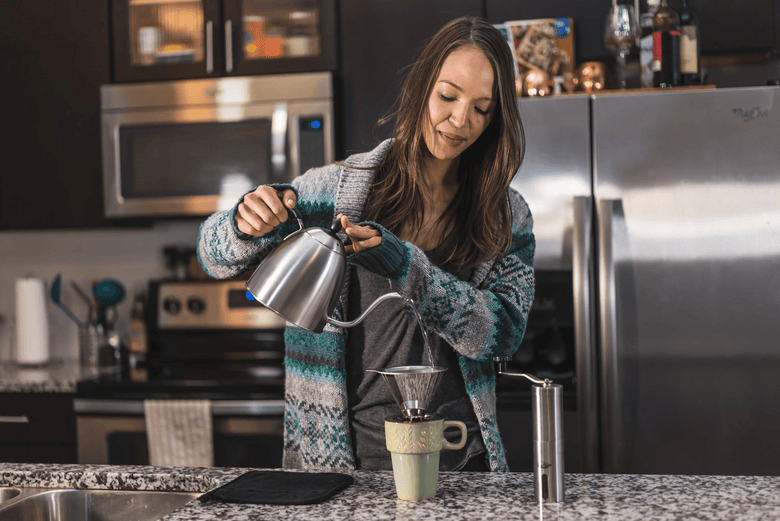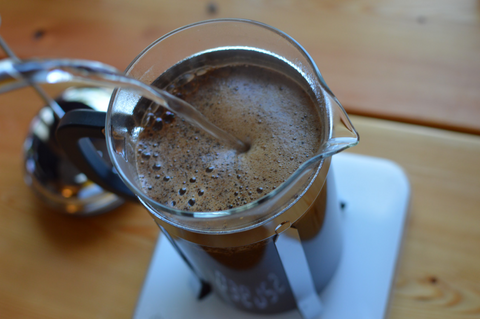Brewing delicious, rich coffee is all about balancing the variables. One of the least considered - yet extremely important - variables is water temperature. It also happens to be one of the easiest to control, set, and never have to worry about again.
Understanding how water temperature affects your coffee can accomplish a few things for you. It gives you the knowledge you need to use water that’s consistent and reliable without having to think about it and it empowers you to make adjustments to your final cup using temperature adjustments if you’d like.
Let me give you a rundown on the best water temperature for coffee and how you can find it in your own setting.
How Water Affects Coffee Extraction
As I’m sure you know already, the hotter your water, the more quickly it extracts things from the coffee grounds. Near-boiling water only takes 2-4 minutes to produce a balanced extraction. Cold water, however, can take anywhere from 3-24 hours to produce cold brew coffee.
The ideal temperature range for hot brewing is 195 to 205 degrees Fahrenheit.
This is hot enough to extract carefully and quickly, but not so hot that it’s uncontrollable.
- Coffee over 205 degrees Fahrenheit tends to over extract things from the grounds very easily, producing bitter coffee.
- Water under 195 degrees has a difficult time extracting, which often leads to sour, underdeveloped coffee.
The 195 to 205 degree range isn’t the objective gold standard for water temperature for coffee brewing. It’s just the range that most people around the world tend to use the most because it tends to make the best, most balanced coffee. You are free to depart from this proven temperature range, but I don’t suggest it unless you’re a seasoned coffee veteran.
There are quite a few coffee professionals who use lower temperatures to achieve different results in their coffee. One World Aeropress Championship finalist in 2013 used water at 176 degrees. Another major figure in the coffee world commonly uses 190 degrees in his Aeropress recipe.
It can be done if you have master-level control of other coffee variables, but most of us like to stick to the tried and true, classic range of 195 to 205 degrees.
The Easy Way To Use Consistent, Reliable Water
If you’re really just looking for a way to get your water to the right temperature consistently and easily, that’s great! Finding your water’s sweet spot is an easy way to eliminate the stress of water temperature for coffee by turning it into a reliable, consistent constant (rather than a variable you have to constantly adjust).
First, find the elevation of where you live. Boiling point at sea level is 212 degrees Fahrenheit. On the high plains of Texas (elevation of 3,000 ft), water boils at 206 degrees. In Boulder, Colorado (elevation of 5,000 ft), boiling happens at 202 degrees.
The higher you are, the lower the temperature you water needs to be to boil.
If you live in an area where boiling occurs between 198 and 205, you’re one of the lucky ones. You can just use your water right off the boil every time, since it boils within the ideal range.
If you live at sea level, you’ll want to let your water cool for a minute or two after it boils before using it. I suggest using a thermometer and stopwatch to see how long it takes for your water to cool down to an acceptable temperature. It could only be 1 minute, but it could also be 5, depending on your elevation and kettle size/material.
If you’re close to sea level, you can also skip preheating your coffee brewer. That way, when you pour in your water that’s above 205 degrees, it’ll instantly cool as the brewer soaks up some of the heat.
If you live at a very high elevation where boiling occurs lower than 198, you’re at risk of under extracting your coffee by brewing with water that’s just barely too cool. You may need to adjust your brewing style slightly to brew the best coffee you can. I suggest trying a few things:
- Preheat your brewing vessel very well to reduce temperature loss when you pour in your water.
- Increase extraction by either grinding your coffee slightly finer or by adding time to your brew.
Should You Manipulate Water Temperature To Improve Your Coffee’s Flavor?
There are ways you can use water temperature to achieve specific flavors, but it’s pretty difficult to do consistently unless you have a specialized kettle that heats water to specific temperatures. These are very handy, but they often run $85 or more and still aren’t razor precise.
If you’re looking to improve your coffee, it’s much easier to leave your water temperature in the ideal zone and use grind size instead to make small changes. Grind size adjustments are quicker and easier to control than water temperature adjustments.
We designed our own coffee grinder, the JavaPresse Manual Burr Grinder, to empower you to be able to refine your coffee’s flavor so you don’t have to mess too much with your water temperature and other inconsistent variables.
If you’re interested in improving your coffee’s quality and feeling the rich satisfaction of a cup well brewed, check it out for yourself.
Water temperature for coffee should be an easy thing to systemize and never worry about again. It’s a lot easier to brew balanced coffee when you can eliminate variables by turning them into reliable constants.
Just remember: the best water for coffee generally agreed to fall in the range 195 to 205 degrees Fahrenheit. At the very least, if you can keep that tidbit of information in your noggin, you’ll be just fine.
---
In the end, the most important factor in great coffee is... your coffee beans! And the easiest way to aways have uber-fresh, high-quality beans is to have them delivered right to your door from your favorite coffee roaster.
Check out our JavaPresse Coffee Subscription! We send you freshly roasted coffee that we've sourced from some of the best sustainably-minded farms in the world. These beans may blow your mind - try if you dare.
Happy brewing!





